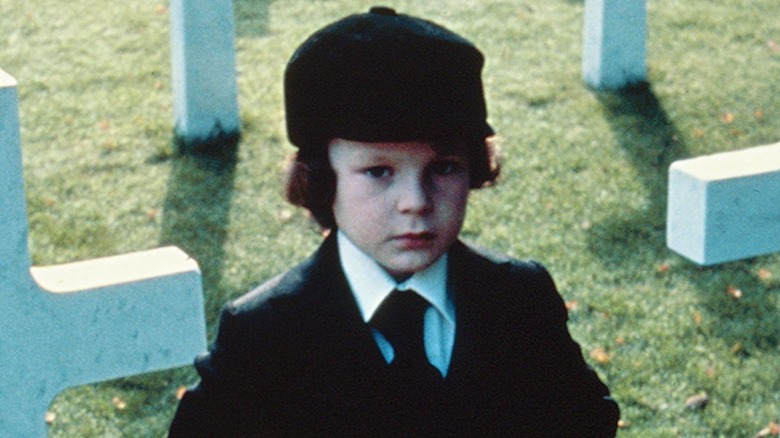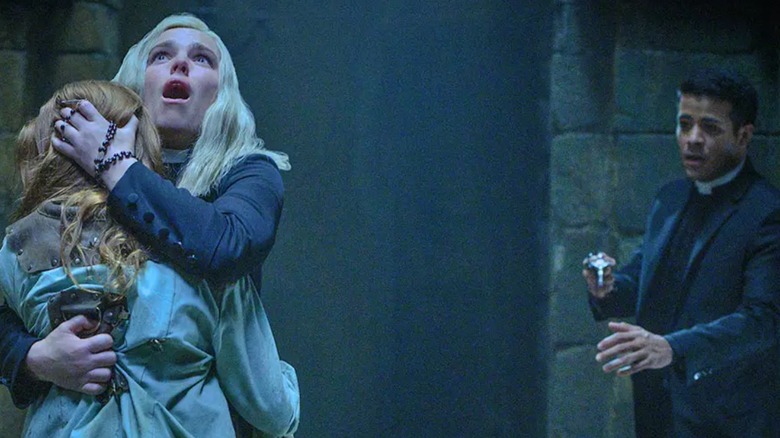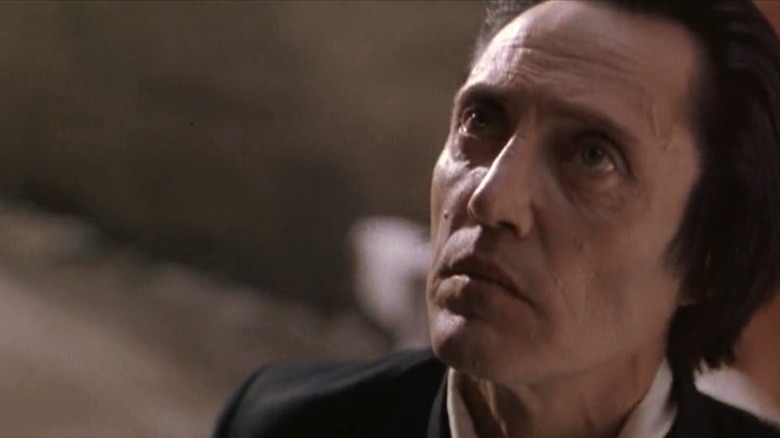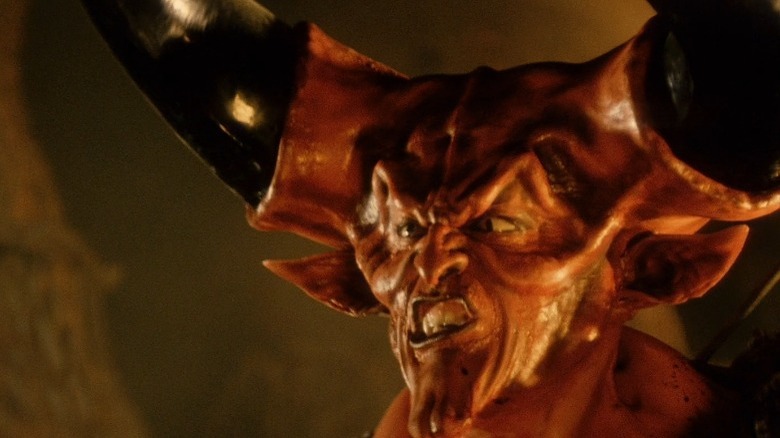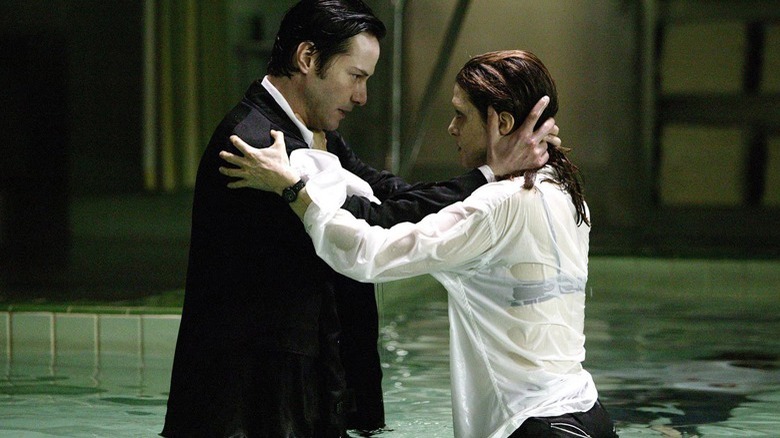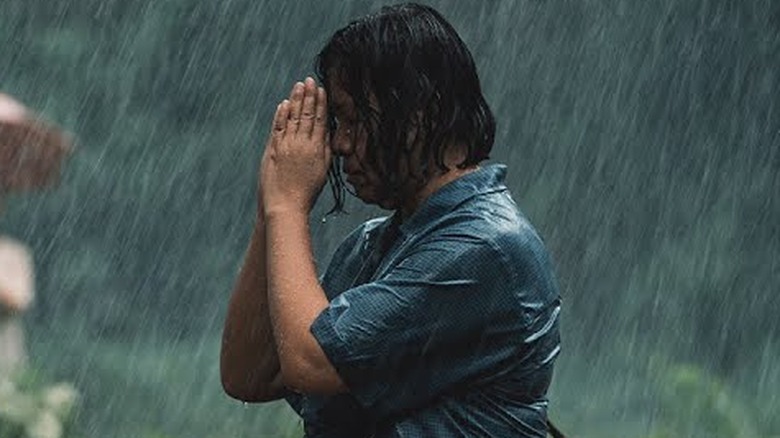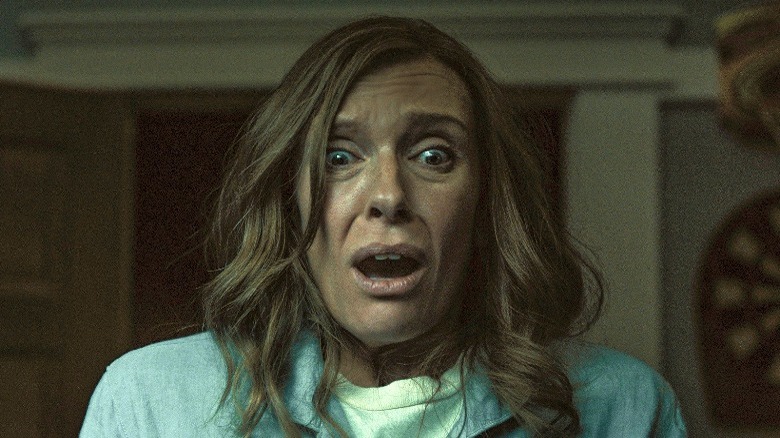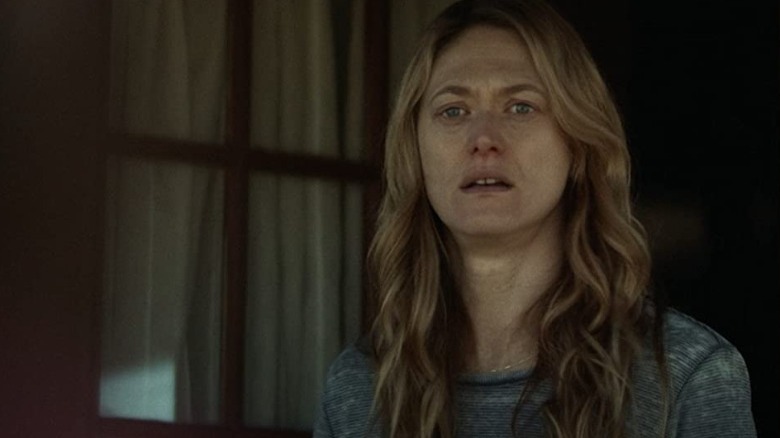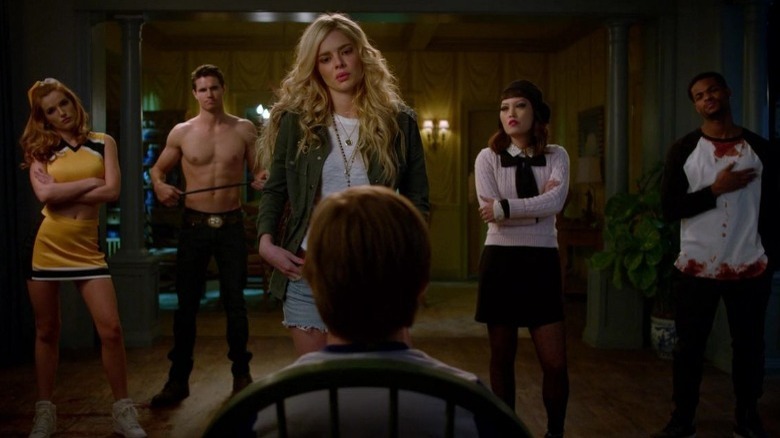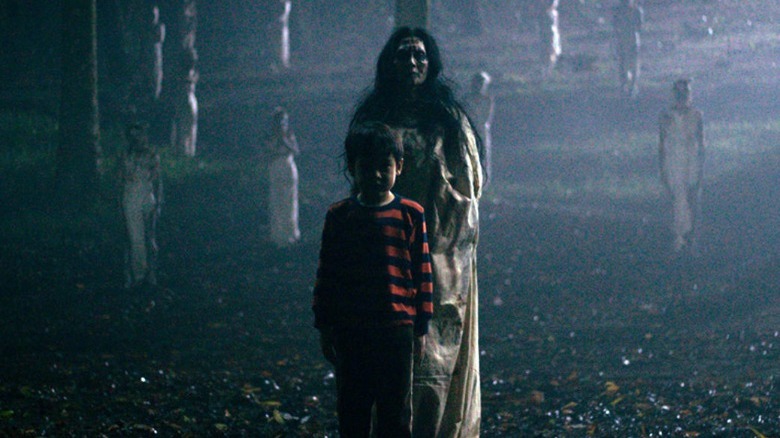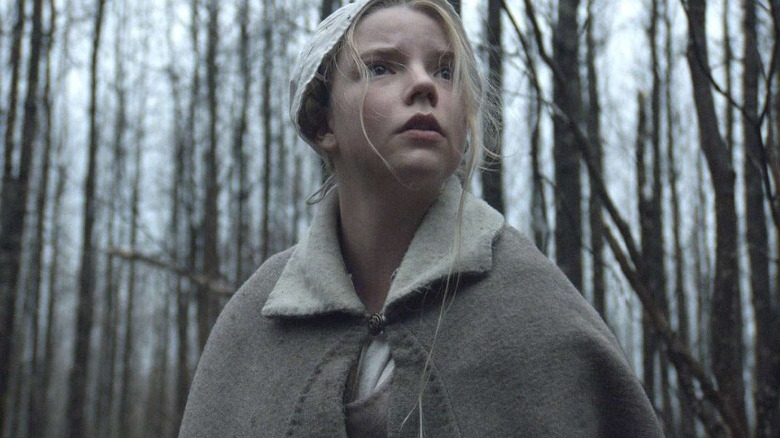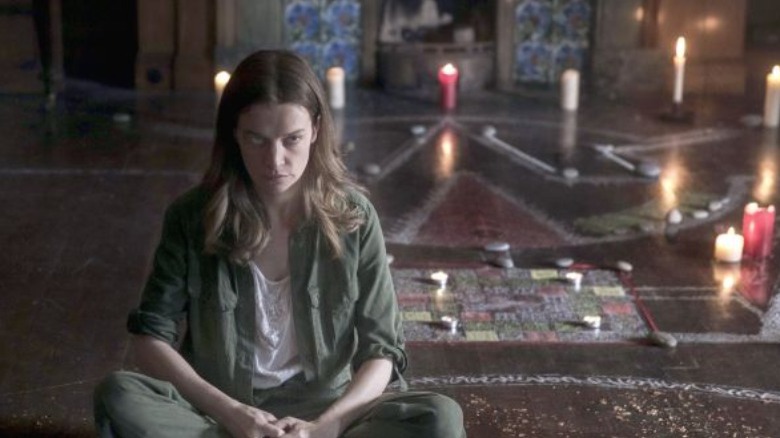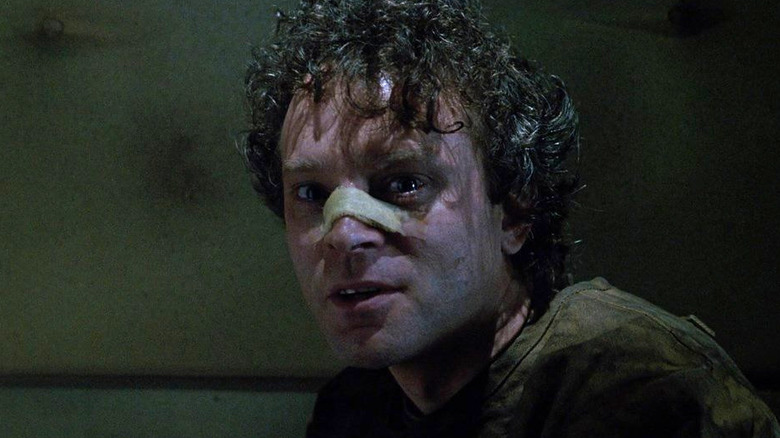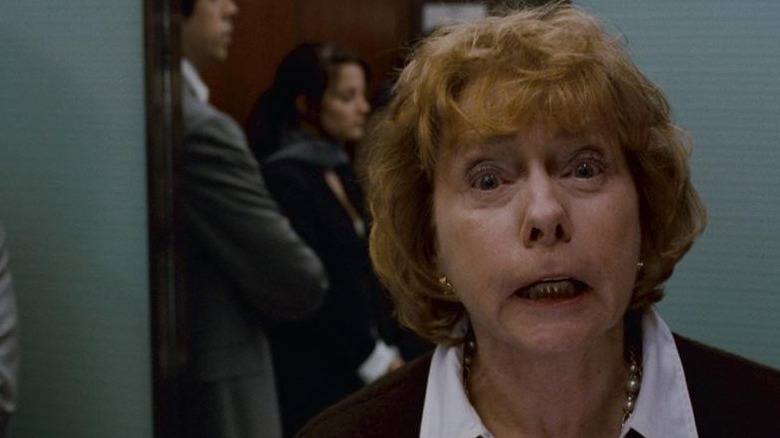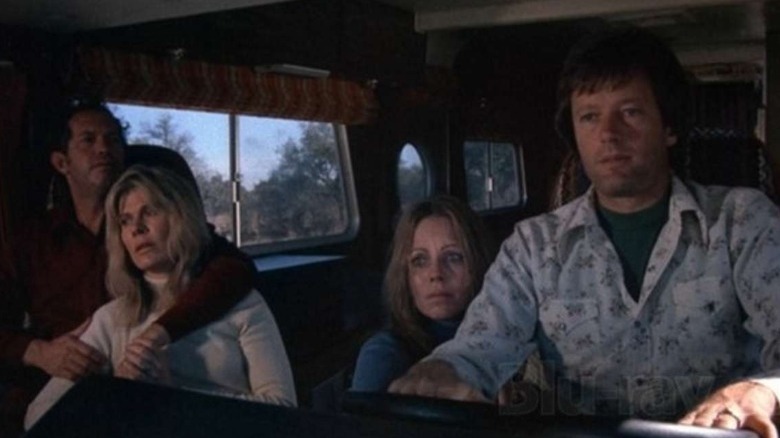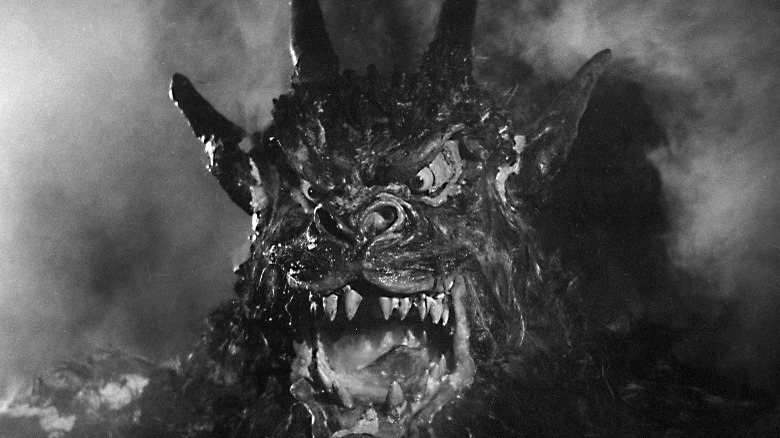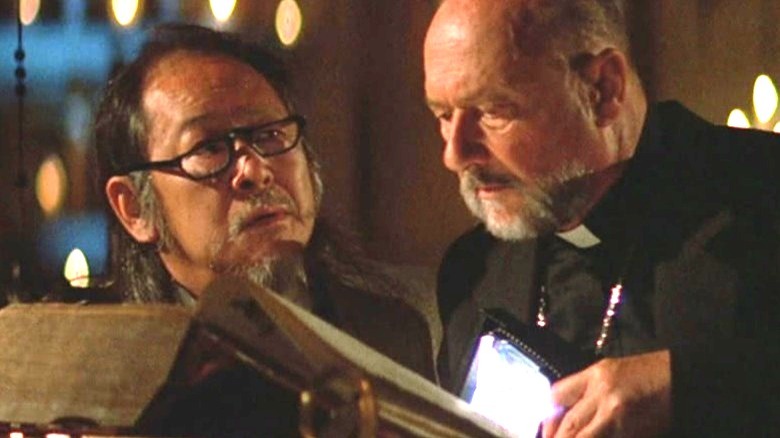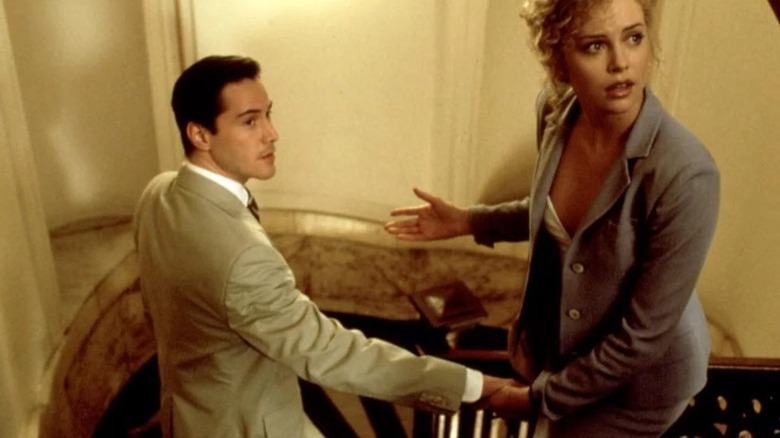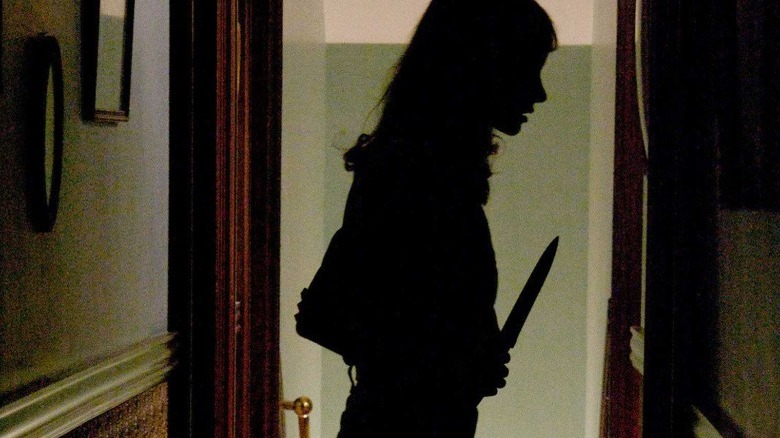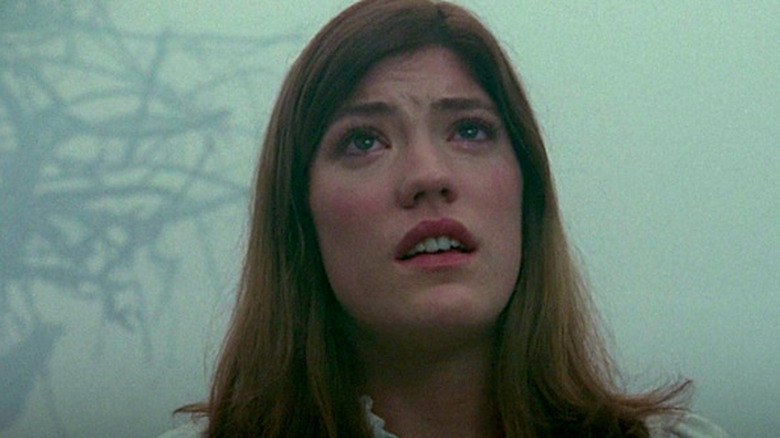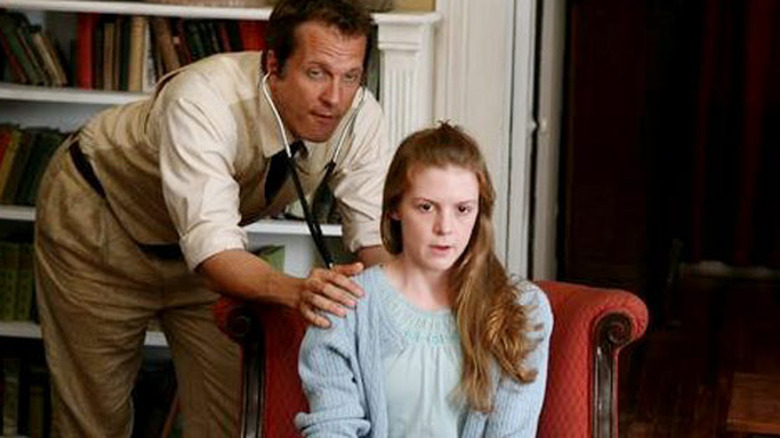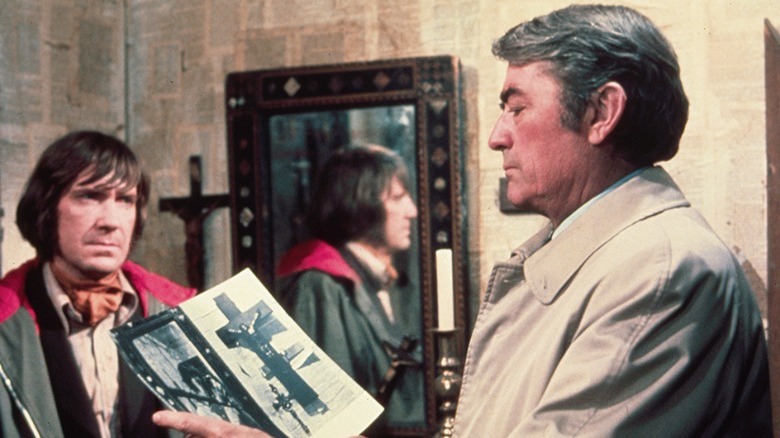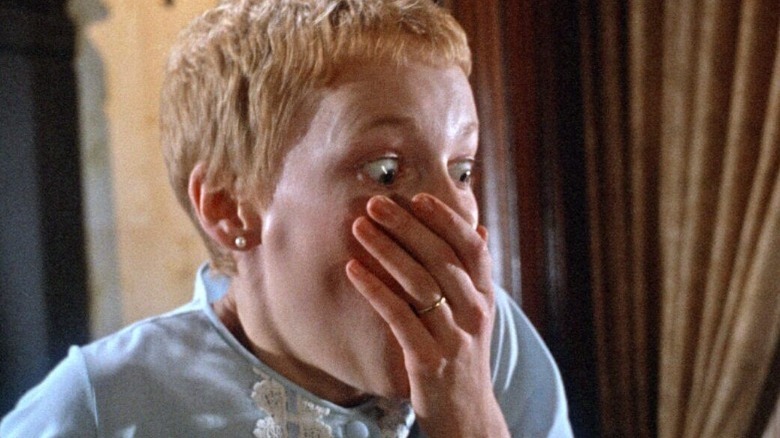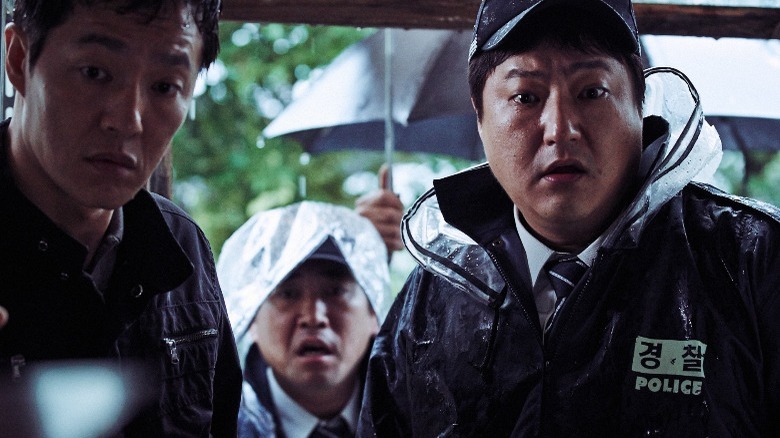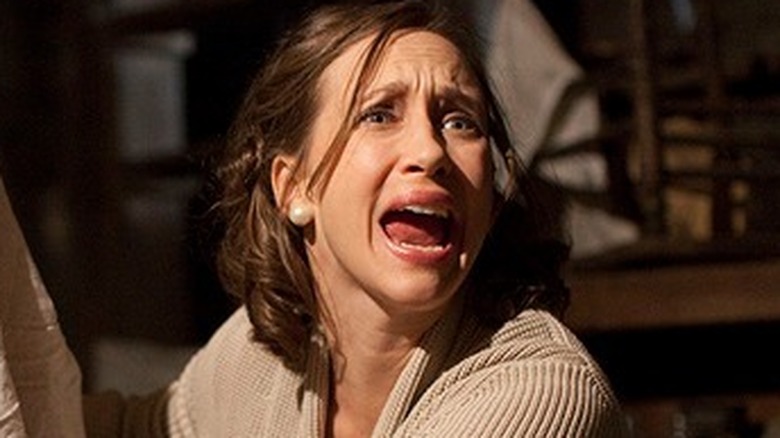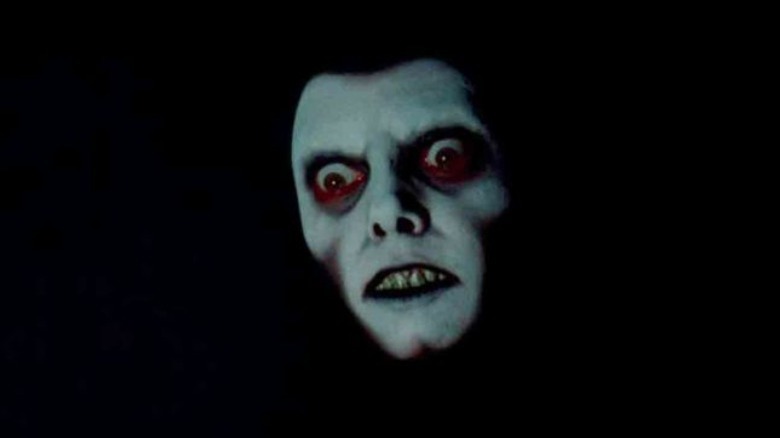The 25 Best Movies About The Devil Ranked
The devil is terrifying. Whether viewers are persons of faith or not, there's something about the devil that cultivates a distinct, almost existential kind of fear. The name alone, uttered in shadows and whispers, is enough to inspire a perennial, frosty chill. For certain audiences, the devil is very much real. For others, the movies he stars in are so chilling and so raw in their depiction of Old Scratch that until the lights go on, whoever is watching just might find themselves believing, too, even if only for a little bit.
If you're looking for some satanic scares, the following 13 movies are the best there are. A combination of old school horror films and contemporary showcases, the devil is central in all of the following films. Some might be about specific demons — "The Exorcist," for instance, is actually about Pazuzu – but so long as the creatures are in league with Satan himself, they count. So, grab your Bible, stock up on holy water, say a prayer, and read on ... if you dare.
25. Prey for the Devil
Daniel Stamm's ("The Last Exorcism") "Prey for the Devil" didn't do big business at the box office, though there's something endearingly nostalgic about seeing the well-worn path of demonic possession revisited in multiplexes nationwide. As demonic possessions become akin to a global pandemic, the Catholic Church reopens its exorcism schools to train a new front line of exorcists to tackle the charge. Jacqueline Byers's Sister Ann, though prohibited as a nun, is given the rare opportunity to train on account of her perceived empathy toward possession victims.
That empathy is rooted in Ann's own experience with a demon in her youth, rendering the battle for the soul more personal than most. Admittedly, "Prey for the Devil," despite the pun in the title, doesn't have quite as much fun with its premise as it might initially seem. While other additions to the canon, such as the stellar "Saint Maud," find ways of reworking old Devilish trappings into new tricks, "Prey for the Devil" is content to coast by with some effective jolts and plenty of conventions. It's not innately bad, and with a PG-13 rating in tow, "Prey for the Devil" is an accessible entry point for young audiences curious to see what this Satan hubbub is all about.
24. The Prophecy
Audiences born in the 1990s and beyond might not even remember "The Prophecy," let alone its many (four, there are four) sequels. The rough sketch of the titular "Prophecy" franchise sees angels fighting amongst themselves to save humanity. Christopher Walken stars in the first as Gabriel, the infamous archangel drawn to Earth in a battle for souls. While it all sounds pretty silly, the B-movie roots belie the true thematic density of "The Prophecy." There's talk of souls being denied entry to Heaven, double-crosses, and queasy alliances with the Devil to make it all work.
Mostly, it does work. Viggo Mortensen's Satan's shift from villain to anti-hero is subversive, even if it mostly amounts to petty grievances over someone stepping over his evildoer territory. The human cast, too, makes the most of the occult-leaden script, with Virginia Madsen's Katherine being a particular standout. Most importantly, though, "The Prophecy" and its many sequels (and recast Lucifers) add some compelling wrinkles to the Satan cinematic mythos. It's stilly, melodramatic, and heaps of fantasy fun.
23. Legend
Ridley Scott's "Legend," a mid-'80s Tom Cruise vehicle, struggled when first released. A C+ CinemaScore didn't bode well for the film's domestic box office legs, and as a result, "Legend" concluded its theatrical run with a collective haul of just $23 million, about $1 million shy of its budget. In recent years, "Legend" has been reappraised and is now considered something akin to a cult classic. A huge part of that is no doubt Tim Curry's portrayal of the Lord of Darkness, arguably one of the most iconic fantasy villains in cinematic history. Curry didn't know what he was getting into when he signed on for "Legend," but he certainly left an impression.
Cruise's Jack O' the Green must try to save his love, Princess Lili (Mia Sara) after she's exploited as bait to kill her land's many unicorns. The Lord of Darkness desires their horns, and it's up to Jack, Lili, and their ragtag crew to stop him. While "Legend" exists in many forms, with different cuts and releases, there's something nostalgic and charming about Scott's fantasy world. Even those unfamiliar with the title likely recognize Curry's antagonist. A giant, red behemoth with horns, it's clearly meant to evoke the Devil. Whether he is or isn't is up for debate, though there's no doubt Curry's Lord of Darkness, like his other villainous portrayals (see: Pennywise), will endure in the annals of film history.
22. Constantine
Francis Lawrence's "Constantine" is finally coming back. In late 2022, it was announced that Keanu Reeves is returning to the lead role for the forthcoming sequel, with Lawrence slated to return to the director's chair. It's been a long time coming. Released in 2005, Lawrence's feature-length adaptation of the DC Comics' "Hellblazer" series was an immediate hit. "Constantine," which follows the exploits of Reeves' exorcist John Constantine, grossed a little over $230 million worldwide. No doubt tethered to the success of Reeves' "John Wick" franchise, it's finally time for John Constantine to return to the silver screen.
In the first, there's a lot going on, though the broad brushstroke sees Constantine endeavoring to help Rachel Weisz's Angela Dodson, a devout Catholic who seeks to prove her twin sister didn't take her own life. Constantine encounters plenty of demons throughout (and friendly driver Shia LaBeouf), though the most notable is undoubtedly Peter Stormare's Lucifer. Believing Constantine belongs in Hell, Lucifer spends a great deal of time scheming to collect his soul, the only one he's personally invested in. Stormare is incredible, and if there's any justice in this world or the next, his endearingly antagonistic Lucifer will return for the new entry.
If you or someone you know is struggling or in crisis, help is available. Call or text 988 or chat 988lifeline.org
21. The Medium
Na Hong-jin of "The Wailing" fame surprised audiences in 2021 when he co-scripted a feature that would sit perfectly alongside his demonic, devilish masterpiece. In Banjong Pisanthanakun's "The Medium," a documentary crew follows Nim (Sawanee Utoomma), a local shaman in the Isan region of Thailand possessed by the spirit of Ba Yan. Ba Yan is a local goddess, one a long lineage of women welcome into their bodies to assist in shamanistic rituals in and around the village. Mink's (Narilya Gulmongkolpech) mother, Noi (Sirani Yankittikan), rejected Ba Yan, choosing instead to practice Christianity. When Mink starts showing signs of possession, the documentary crew is there to capture a maelstrom of bloodshed and death.
While "The Medium" is never explicit in which spirits, exactly, are possessing Mink — it could be argued to be either an aggrieved Ba Yan or something else entirely — there is undoubtedly clear evidence that the work of the Devil — however audiences choose to conceptualize Him — is responsible. Like the best of Na Hong-Jin's works, the true terror of "The Medium" lies not only in its ambiguity but its recognition of universal evils among distinct faiths. Evil is evil, and possession is possession. Neither Shamanism nor Christianity is enough to keep someone safe. That's the kind of terror that possesses an audience long after the credits roll.
20. Hereditary
"Hereditary" is truly its generation's "The Exorcist." While it might be slower, less bombastic, and considerably moodier, there's no denying the efficacy of Ari Aster's sensational, candle-lit scares. "Hereditary" was so successful, it was A24's highest-grossing worldwide release prior to 2022's "Everything Everywhere All at Once." "Hereditary" is a simple tale told with devious intention, and resultantly, it's as close to a modern masterpiece as horror comes.
Toni Collette stars as miniature artist Annie Graham. Introduced at her mother's funeral, Annie slowly unravels, incapable of sufficiently processing what appears to be grief, though is likely considerably more. When that grief is compounded by a shocking death, Annie begins to suspect her mother has invited an otherworldly presence into her home. While the Devil exists on the periphery, the true evil here is Paimon, an ancient deity and servant to Lucifer himself. While the mythology is only briefly touched on, glimpsed in tattered pages, and spoken with frayed tongues, the perennial presence of something demonic renders "Hereditary" distinctly, enduringly haunting. If the Devil were more central, this would undoubtedly rank higher.
19. The Dark and the Wicked
Bryan Bertino's "The Dark and the Wicked" is what happens when you combine the stalk-and-slash terror of his own "The Strangers" with the ponderous, existential terror of William Friedkin's "The Exorcist." "The Dark and the Wicked" is scary. Eschewing jump scares (though there are plenty of those here too) for a dense, oppressively dark atmosphere, Bertino's horror opus — arguably the best he's done — is one of the century's scariest movies. Just don't expect to sleep much afterward.
Marin Ireland and Michael Abbott Jr. star as siblings Louise and Michael. The pair return to their childhood home together after hearing their father is sick. Shortly after their arrival, their mother takes her own life, and from there, the siblings are left to pick up the demonic pieces. There's clearly something in their house, a Devilish presence from Hell, one feasting on not only their sanity but their ailing father's as well. While the graphic content and aggressively dour tone render "The Dark and the Wicked" less accessible than the popcorn frights of "The Strangers," it's a remarkably well-made tale of possession and the demons within one's own blood.
If you or someone you know is struggling or in crisis, help is available. Call or text 988 or chat 988lifeline.org
18. The Babysitter
McG's filmmaking style might not be for everyone. It's bombastic, loud, and frenzied in both characterization and action. "The Babysitter: Killer Queen" might be McG in the truest sense, for better or worse, but the first, the aptly titled "The Babysitter," is a tender excursion to a more sentimental, nostalgic McG. Here, Samara Weaving's Bee is tasked with babysitting school nerd Cole (Judah Lewis). She's the hottest high schooler in town, a ridiculously grunge, fun, flirty babysitter, the kind every adolescent boy dreams of having watch over them. After all, her name is Bee.
Unfortunately, Bee and several of her friends, including Bella Thorne's Allison and Robbie Amell's Max, are members of a demonic Devil cult. When Cole awakens in the middle of the night to find them sacrificing a classmate, he becomes their new target. The race is on for Cole to survive the night and avoid becoming their latest sacrifice. While a lot of the goodwill is undone in the sequel, "The Babysitter" is as heartfelt as it is tender. It's a gory love letter to '80s horror in the best way, a devilishly witty and warm streaming surprise.
17. Satan's Slaves
Joko Anwar's "Satan's Slaves," a remake of the 1980 Indonesian horror film of the same name, is one of the most terrifying movies released this century. Indonesia's answer to "The Conjuring," both it and its 2022 sequel are viciously scary. With a distinct playfulness, the Devil cult shenanigans go down easily, though they're liable to incite nightmares galore, what with its frightening cultists and shrouded pocong (a Javanese ghost).
Tara Basro's Rini is the audience entry point, a young woman living with her parents and two brothers in the country. When her mother dies, the family grieves, not knowing the full scope of the nightmare in store for them. With a smattering of James Wan's trademark misdirection for its most visceral scares, "Satan's Slaves" might be as loud as its Hollywood brethren, though its distinct cultural roots run deep. The family soon finds themselves contending with a cult of Satan-worshipping cult members, and while I won't spoil the many reveals, it's a fresh, uniquely human way of contextualizing its paranormal jolts. "Satan's Slaves" is not to be missed.
16. The Witch
"The Witch" might not have been the horror phenomenon A24's marketing material suggested (that distinct honor still belongs to Ari Aster's "Hereditary"), but even though director Robert Eggers "can't stand" his breakout film now, there's no denying "The Witch" was unlike anything seen before. With a feel for period the genre hasn't seen since — that dialogue is deliciously traditional — "The Witch" might give new meaning to slow-burn horror, but it's remarkably successful no matter its pace.
Here, Anya Taylor-Joy's Thomasin joins her family near the provincial wilderness after they're cast out from their Puritan settlement. While things go well enough at first, soon, infant Samuel is ostensibly stolen by a witch in the woods, sending the family into a spiral of religious persecution and possession. Infamously, the goat Black Philip, unassuming throughout, soon transmorphs into the Devil, asking young Thomasin to sign her life over. It's a remarkable horror ending, and whether the Devil is incarnate or not, there's no denying the sinister edge even the mere evocation of his name lends to the proceedings.
15. A Dark Song
Liam Gavin's "A Dark Song" is one of the most striking, original, and terrifying horror debuts. Its meandering pace and prioritization of suggestive atmosphere over visceral scares likely turned most mainstream audiences away, a shame since "A Dark Song" is one of the most affecting — and genuinely life-affirming — movies about the occult and Devilish rituals around.
Catherine Walker's Sophia Howard enlists the assistance of occultist Joseph Solomon (Steve Oram) in summoning her guardian angel, a presence with whom Sophia could ostensibly ask for anything. Revenge. Power. Knowledge. Whatever it is, if Sophia can endure months of suffering to actualize the ritual, that access will belong to her. The early-goings are trippy, with temporal distortion and plenty of gross requests, including having Sophia drink Joseph's blood. As the months drag on, the appearance of some figure from another realm grows clearer — in effect, the Devil and his legion of demons are drawn toward the isolated home by dint of the ritual. Sophia wanted an angel, though she might well have summoned the Devil. Tense, gorgeously shot, and tenderly acted — seriously, the ending here is a bonafide tearjerker — "A Dark Song" is hardcore horror with heart.
14. The Exorcist III
James Cameron's "Aliens" is the exception, not the rule. Critically and commercially successful horror projects rarely, if ever, succeed in franchise form (just ask Jamie Kennedy's Randy Meeks in "Scream 2"). William Friedkin's "The Exorcist" is arguably the greatest horror movie ever made, and certainly the scariest movie about the Devil ever made. The entire franchise was almost killed with the 1977 release of John Boorman's "Exorcist II: The Heretic." Largely considered one of the worst horror movies ever made, it was a disastrous effort, one that inexplicably failed at capturing anything even resembling the original.
All hope seemed lost until 1990, when the original novel's scribe, William Peter Blatty, helmed "The Exorcist III." Originally conceived in screenplay form, the script was adapted for Blatty's novel, "Legion," and then adapted again as an "Exorcist" film sequel. George C. Scott's Lieutenant William F. Kinderman, a character from the original, investigates a series of murders in and around Georgetown 15 years after the first. Of course, he soon finds himself up against the forces of good ol' Satan, with demons possessing several bodies to do the Devil's bidding. It's undoubtedly the best sequel in the franchise, opting to do something new — something sinisterly procedural — with the well-worn material. It's sensationally scary, deeply existential, and deserves to stand alongside the original. Plus, that jump scare.
13. Devil
"Devil" is a lot like "The Nightmare Before Christmas" in that it is routinely misattributed to the wrong director. No, M. Night Shyamalan did not direct "Devil." John Erick Dowdle did. Though adapted from a story of Shyamalan's, the writing and directorial duties were placed in other hands. Still, it's an easy misattribution to make, on account of both the marketing and how Shyamalan's inimitable narrative and filmmaking techniques are evident all over "Devil." An ensemble thriller, in "Devil" five strangers are trapped together in an elevator and soon realize that one of them is the literal Devil himself.
With quick shocks, lots of paranoia, and the kind of twist ending one comes to expect from a Shyamalan production, "Devil" is both familiar and unpredictable. It earns its scares earnestly, the acting is worthwhile, and it's a prime example of a high concept exploited to maximum effect on a modest budget. The world could certainly use more of this kind of devilry.
12. Race with the Devil
"Race with the Devil" is an early "Mad Max" prototype with a horror vibe and a whole lot of angry, violent Satanists. Peter Fonda, Warren Oates, Loretta Swift, and Lara Parker star as a pair of married couples on an RV trip to Aspen when they run afoul of a satanic sacrifice. The first act is a tense, slow burn, as the couples, having barely escaped the cult, continue their trip, unaware that the cult is watching their every move. The third act is when everything hits the colloquial fan. Chased down across the freeway, the vehicular stunts are practical, well-choreographed, and genuinely thrilling. Fonda gets to jump between moving vehicles, guns are fired, and the protracted action sequence is an expert example of how to do car chases right.
Not everything about "Race the Devil" is perfect. As deliciously dour as the ending is, the third act is a swift shift into action territory that belies the tension that preceded it. Similarly, the gender politics are dated, even for 1975. As the two wives, Swift and Parker are worse than useless — they're practically liabilities. It's especially strange to see Swift behave so helplessly given her other screen credits, and it's frustrating to see these two talented actors scream and cry without any agency. Still, it's a one-of-a-kind film. For fans of paranoid thrillers with satanic undertones, there's little better.
11. Curse of the Demon
"Curse of the Demon" (also known as "Night of the Demon") is genuinely scary in a way that few classic horror films are. That isn't to say that other older films aren't frightening, but "Curse of the Demon" is almost prescient in the way it moves to the rhythms of more contemporary horror outings. Directed by Jacques Tourneur, its production was notoriously rife with conflict, with tension rising over both its length and the decision by producer Hal E. Chester to insert the demon itself into the climax; Tourneur wanted to leave it to the viewers' imaginations.
"Curse of the Demon" stars Dana Andrews as Dr. John Holden, a professor intrigued by the death of Professor Harrington (Maurice Denham) and his work on the occult, namely his interest in exposing a satanic cult. Holden is soon in over his head and stuck in a cycle of death, curses, and, yes, giant demons. The decision to show the demon itself is still a point of contention — some think it looks silly, while others appreciate the brazenness of the choice — but regardless, there's little that matches the potent thrills of "Curse of the Demon." Grounded with peripheral supernatural chills, it reminds audiences that if the devil is real, he exists in shadows and whispers, in the minds and hearts of evil men. It's true in a way more bombastic entries can't quite manage.
10. Prince of Darkness
"Prince of Darkness" is prime late '80s John Carpenter. It's a little goofy, stunningly melodramatic, and full of so much religious dogma and quantum jargon that it's liable to make one's head spin all the way around. Still, the second entry in what director John Carpenter calls his "Apocalypse Trilogy" (coming after "The Thing" and preceding "In the Mouth of Madness") is a glorious time. It's gory, silly, and brazenly entertaining. The devil is in the details.
Donald Pleasance stars as a Catholic priest who, along with Professor Howard Birack (Victor Wong) and several of his students, investigates a mysterious green liquid in the basement of a Los Angeles monastery. The monastery belonged to the Brotherhood of Sleep, an old order of men who allegedly communicated through dreams. Shortly after arriving, they deduce that this liquid is the Anti-God, bound to the realm of anti-matter, and likely the father of Satan himself. If that doesn't make much sense, don't worry — "Prince of Darkness" doesn't seem to quite understand it either. With ongoing rumors of a new show in development and Carpenter's trademark gonzo gore and kinetic energy, "Prince of Darkness" is a curious, devilish beast not to be missed.
9. The Devil's Advocate
It's not a spoiler, per say, to acknowledge that Al Pacino plays the devil himself in "The Devil's Advocate." Look, it's right there in the title. Still, when the film starts, we're introduced to Pacino as John Milton (get it?), the head of a New York law firm who offers to hire Keanu Reeves' Kevin Lomax, an unscrupulous defense attorney who has never lost a case, even if it means letting guilty men walk free. Kevin subsequently accepts the offer following a high-profile win, and he and his wife Mary (a sensational Charlize Theron) move to New York.
Haunting occurrences start almost immediately. As Kevin begins his allegorical rise, Mary unravels. She is plagued by visions and nightmares, including a graphic scene in which she sees a child playing with her removed ovaries, and an increasing sense of isolation, compounded by Kevin's change in demeanor. Kevin's career becomes harder to manage as he chooses winning over the wellbeing of himself and those he loves. A critical and box office triumph, "The Devil's Advocate" has been somewhat lost to the annals of time. Seek it out.
8. The House of the Devil
"The House of the Devil" director Ti West has had a prolific career. Beyond classics like this and "The Innkeepers," West has been quite active in genre television, directing episodes of "Scream: The TV Series" and "The Exorcist," among others. "The House of the Devil" is his third directorial feature, although given the lackluster quality of his first two (sorry, fans of "The Roost"), it might as well be his first.
Jocelin Donahue is authentic as a college student strapped for cash. Eager to secure a new rental on campus, she takes a cryptic babysitting gig from a job board, only to discover that there are no children — she simply needs to watch the house. She's desperate enough to accept the job anyway, and it's not a spoiler to reveal that the homeowners have other, devilish plans. Tense, violent, and replete with exceptional practical gore effects (including one genuinely shocking and unexpected kill) and an early turn by Greta Gerwig, "The House of the Devil" is throwback horror at its best.
7. The Exorcism of Emily Rose
Several months ago, "The Exorcism of Emily Rose" director Scott Derrickson revealed on Twitter that the movie was originally hit with an R rating on account of star Jennifer Carpenter's disturbing facial distortions. Done practically in camera, the MPAA found Carpenter's performance so chilling and visceral that they refused to issue the PG-13 the studio wanted until Derrickson cut some of Carpenter's more disturbing moments.
Loosely based on the true story of Anneliese Michel, a German woman infamously killed during an exorcism in 1976, "The Exorcism of Emily Rose" is a courtroom procedural with a supernatural shading. Laura Linney stars as the defense attorney representing Tom Wilkinson's parish priest, who is charged with negligent homicide after Emily Rose dies during his ceremony. The movie jumps back and forth between the courtroom and Emily's possession, showing both her early symptoms and the eventual demonic takeover. Though somewhat dated — the digital faces and exhausting jump scares are pure '00s — the performances, especially Jennifer Carpenter's, are so incredible that the movie will terrify even the most agnostic horror fan.
6. The Last Exorcism
Just as "The Exorcism of Emily Rose" was anchored by an awards-worthy performance from Jennifer Carpenter, the found-footage shocker "The Last Exorcism" largely works on account of Ashley Bell's sympathetic yet chilling performance as a young girl, Nell, whose father believes she is possessed by Satan.
Patrick Fabian plays Cotton Marcus, a reverend who, along with a camera crew, seeks to delegitimize exorcisms. He is attracted to Nell's case, and in the early goings, director Daniel Stamm keeps the uncertainty terrifyingly high. Audiences aren't quite sure whether Nell is possessed or just deeply ill. I won't spoil the answer, but Bell's performance holds the entire thing together, exhibiting the same disturbing physicality and penchant for unnatural contortions as Jennifer Carpenter. It's a rapturous performance, and worth the price of admission alone.
5. The Omen
Children are terrifying. Even the nice ones are so unpredictable that they can inspire terror. "The Omen," directed by Richard Donner and written by David Seltzer, takes that idea and runs with it. Gregory Peck and Lee Remick star as Robert and Katherine Thorn, a couple living in Rome, where Peck's Robert works as a diplomat. When their son dies during childbirth, Robert is convinced by Father Spiletto (Martin Benson) to adopt a child whose mother died, which he keeps secret from Katherine. They name this child Damien. Damien is the Antichrist.
With incredible death scenes, including the best beheading ever committed to celluloid, and an intoxicating take on the satanic panic, "The Omen" is smart, high-toned horror. Cerebral while also conforming to parameters of the genre, "The Omen" is one of the best devil movies ever made. It's anchored by stellar performances — as Damien, Harvey Spencer Stephens is so exceptional that he earned a Golden Globe nomination, while Jerry Goldsmith won an Oscar for his score. "The Omen" is enduring, too, having earned three sequels, a remake, and even a (quickly canceled) television series. The Antichrist is here to stay.
4. Rosemary's Baby
"Rosemary's Baby" is a classic. Director Roman Polanski subverted the entire horror genre with his star-studded and deliciously restrained tale of a woman, Rosemary (Mia Farrow), who is pregnant with the Antichrist. There are supernatural horrors throughout, including the movie's infamous ending, although for most of its run "Rosemary's Baby" is unconventionally grounded. The scares emanate from creepy neighbors, including an Oscar-winning Ruth Gordon, pregnancy drinks, and trips to the doctor.
Mia Farrow holds the entire enterprise together, embodying both the vulnerability of a new mother and the conviction of second-wave feminism, especially as her husband, Guy (John Cassavetes), gaslights Rosemary into thinking nothing is wrong. A cautionary tale replete with demonic iconography, "Rosemary's Baby" is well-regarded 50 years after its release for a reason. Terrifying, unconventional, and simply gorgeous to look at, no other movie has managed to capture its power (and that includes its made-for-TV remake).
3. The Wailing
"The Wailing" is one of the scariest movies ever made. Na Hong-jin's operatic, dense, and thoroughly frightening sixth feature is almost impossible to describe. Ostensibly the story of a small village in South Korea rattled by the arrival of an enigmatic Japanese stranger (Jun Kunimura), "The Wailing" is a frenzied sprint through different horror subgenres. A psychological thriller, an exorcism movie, and a blockbuster grounded in Korean mythos, "The Wailing" is a lot of things. At no point during its nearly two-and-a-half-hour runtime, though, is it anything less than captivating and terrifying.
I won't spoil the ending, but the final half hour (which feature the devil, though I won't say how) is unreservedly the scariest 30 minutes of film I've seen in the past decade. With genre-defying performances from Kwak Do-won and Chun Woo-hee and so much mythology to unpack and explore, "The Wailing" is classic cinema. It transcends time and genre with an indefinable capacity to scare. Don't miss this one.
2. The Conjuring
James Wan is a master. Working on a larger scale in the genre he finds most comforting, the shock maestro reinvented both himself and the horror genre with "The Conjuring." Gone was Wan's "Saw"-style gore and macabre Gothicism (see "Dead Silence"). Instead, with stars Vera Farmiga and Patrick Wilson playing real-life demonologists Ed and Lorraine Warren, "The Conjuring" has enough heart to match its terrifying scares.
Wan is at peak form here, turning every nook and cranny of the film's farmhouse setting into a springboard for gut-wrenching frights. Children's games, toys, and even wardrobes are used to maximum effect. The cast, which also includes Lily Taylor and Ron Livingston, are more than up to selling the terror. Additionally, Wan wisely keeps many of the horrors unseen, and never lets certain haunts overstay their welcome. "The Conjuring" is the rare horror film that works both in the moment, satisfying that immediate need to jump and feel fear, and long after the credits roll.
1. The Exorcist
"The Exorcist" is a classic, and were it not included here, I wouldn't fault readers for suspecting that I myself had been possessed by the devil. William Friedkin's Oscar-winning horror opus, based on the novel of the same name by William Peter Blatty, is a subversive, thoroughly terrifying exploration of one girl's demonic possession. Graphic, vile, and almost antagonistic, it didn't earn its reputation as the scariest movie ever made for nothing.
Hardened genre veterans might dissemble the truth 50 years after release and allege that "The Exorcist" isn't all that scary, but the fact remains that without "The Exorcist," the horror genre — and the entirety of the filmmaking landscape — would look very different today.
Ellen Burstyn stars in the film Chris MacNeil, an actress filming in Georgetown who suspects that her daughter, Regan (Linda Blair), has been possessed by some demonic force. Friedkin wisely stacked "The Exorcist" to the rafters with stellar performances, breakthrough effects work, and lots of nuance, all of which make its most terrifying elements — like, say, that crucifix scene — more palatable to general audiences. It was groundbreaking in all the right ways, and for 50 years, has possessed an entire genre.
